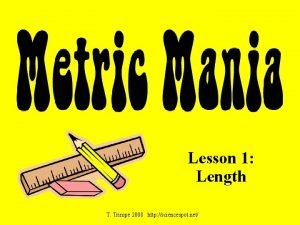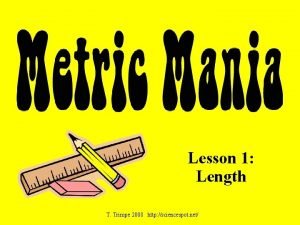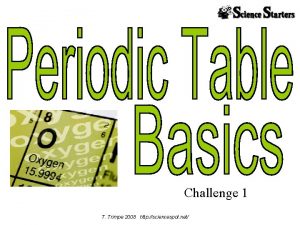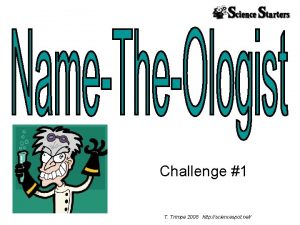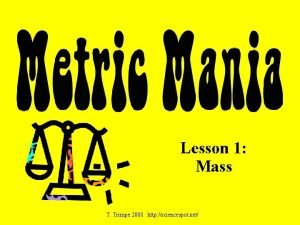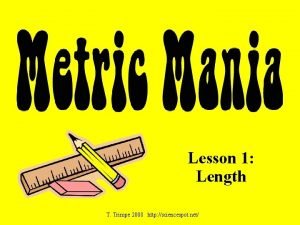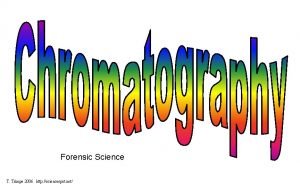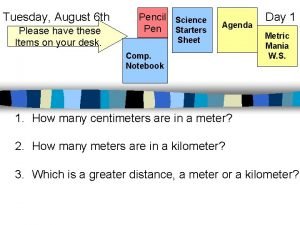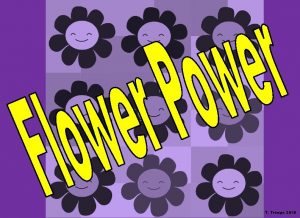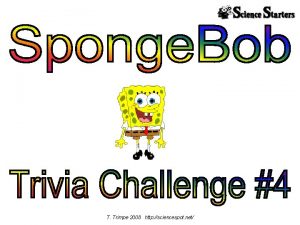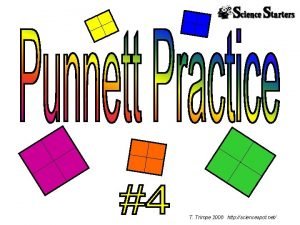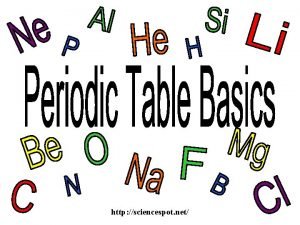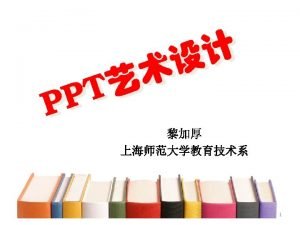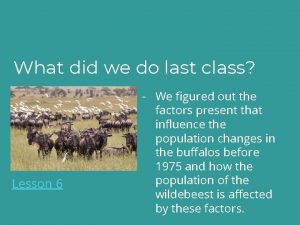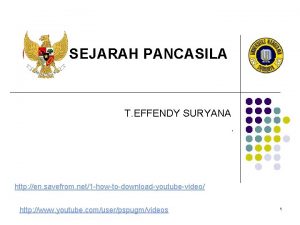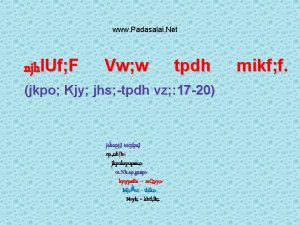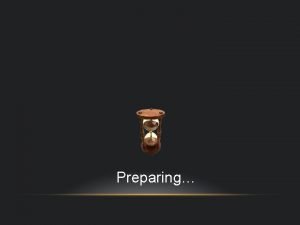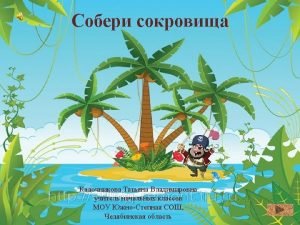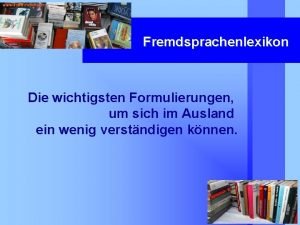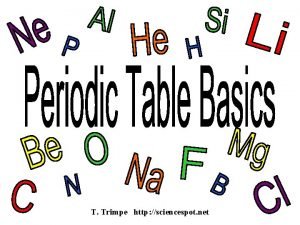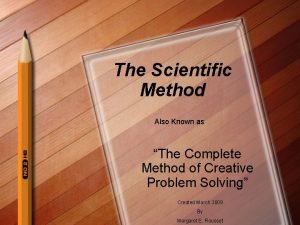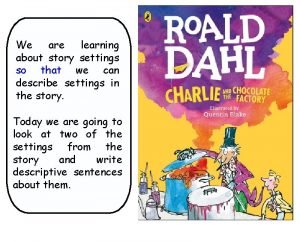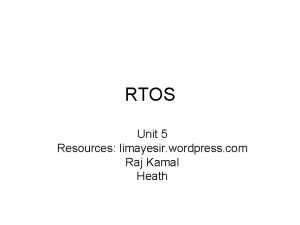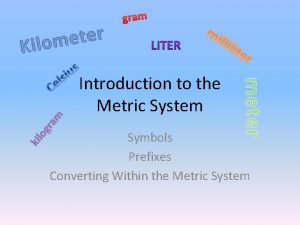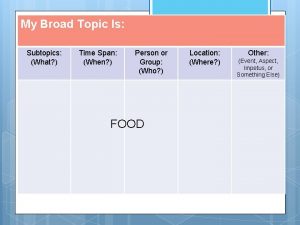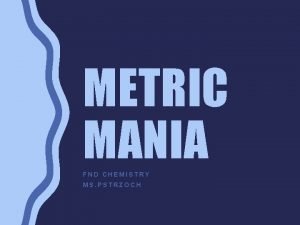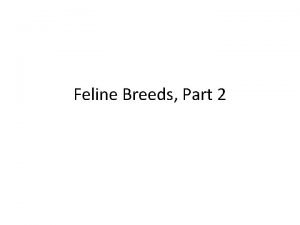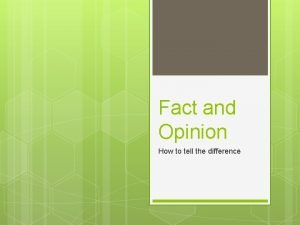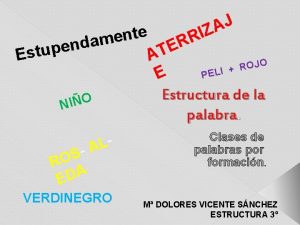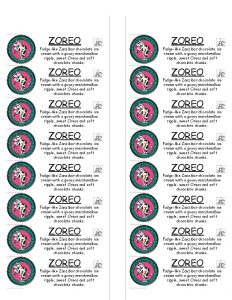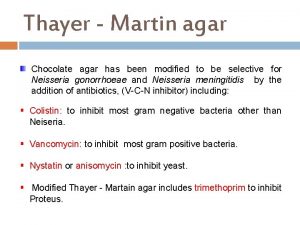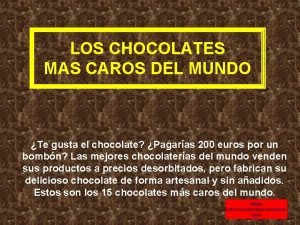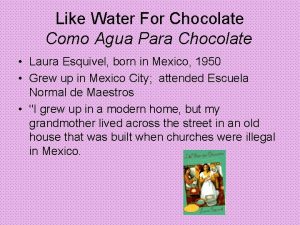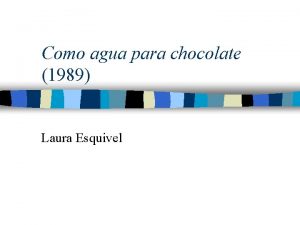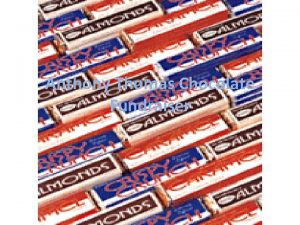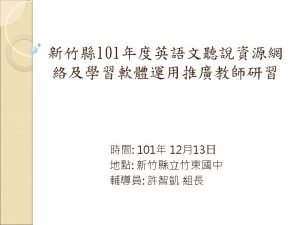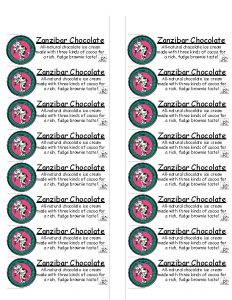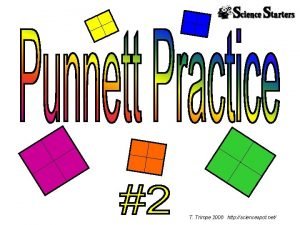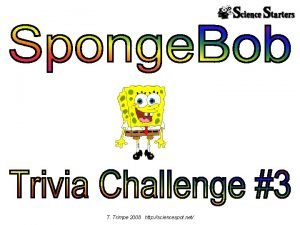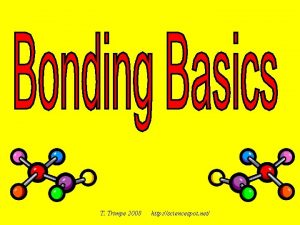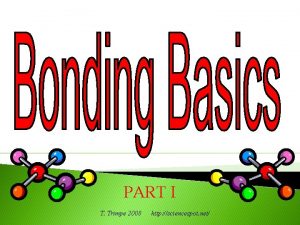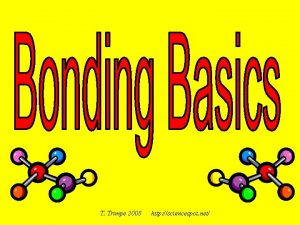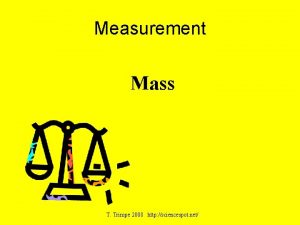Chocolate Challenge T Trimpe 2008 http sciencespot net




























































































































































- Slides: 156

Chocolate Challenge T. Trimpe 2008 http: //sciencespot. net/

Find the 12 differences between the two pictures. Source: http: //www. smart-kit. com/wp-content/uploads/2008/03/chocolate-puzzle. jpg

The answers are … Source: http: //www. smart-kit. com/wp-content/uploads/2008/03/chocolate-puzzle. jpg

Golden Treasure

Find the 6 differences between the two pictures.

The answers are … Answers: Missing coin, belly button, tooth, shirt hem, sword, missing polka dot


Fiber Questions • To test the dye in a particular fiber, it can be extracted and then tested using _____. • The most common method used to identify fibers is _________. • The highest level of protection for a concealed protective vest is _______ • The process of breaking larger molecules into smaller ones using heat is called____. • The basic unit of a polymer is a _________.

Fiber Questions • To test the dye in a particular fiber, it can be extracted and then tested using __TLC_______. • The most common method used to identify fibers is _______pyrolysis__gas chromatography______. • The highest level of protection for a concealed protective vest is ____IIIA_____ • The process of breaking larger molecules into smaller ones using heat is called__pyrolysis_____. • The basic unit of a polymer is a _____monomer____.


Can you identify the types of fibers shown? A B D Think About It … C E (1) Which samples are natural fibers? (1) Which samples are artificial – regenerated fibers? (3) Which samples are artificial - synthetic fibers? F

A Types of Fibers - Key Acrylic Yarn Polyester Yarn B D Cotton Yarn Rayon Rope C E Nylon Rope Wool Yarn 1. Natural Fibers – B, F 2. Artificial/Regenerated Fibers – E 3. Artificial/Synthetic Fibers – A, C, D F

Assignment: Carefully watch the Video clip and answer the following Questions: 1. The warp is horizontal or vertical? 2. The weft is horizontal or vertical? 3. How long does the fabric stay in the dye? 4. What does thermosetting do? Fabric Production - How Its Made Fabrics 4: 30

Fabric Production • Fabric Production - How Its Made Fabrics 4: 30

Assignment: Carefully watch the Video clip and answer the following Questions: 1. What does the word chromatography mean? 2. What is the purpose of chromatography? 3. Name some of the items mentioned that chromatography can be used to separate. Chromatography Simple Chromatography Project - 1: 04

Assignment: Carefully watch the Video clip and answer the following Questions: 1. . Where is the lab? 2. What does chromatography mean? 3. How can chromatography be used in a crime lab? Uses of Chromatography Lab TV Colorwriting – Jet Fuel

Assignment: Carefully watch the Video clip and answer the following Questions: Uses of Chromatography Simple Chromatography Project - 1: 04

Uses of Chromatography • Lab TV Colorwriting – Jet Fuel • Simple Chromatography Project 1: 04

Chapter 6 – Fibers

Fibers are everywhere! • Fabrics are both a good source of fibers and excellent carriers of fiber evidence.

• Because textiles are mass-produced, it is difficult to trace a fiber back to a specific source, but fiber evidence is valuable because it creates links among victims, suspects, and places.

Locard’s Exchange Principle once again. . . • Fibers are transferred between individuals and objects when they come into contact. • Locard’s principle states that every contact leaves a trace.

• It makes sense, therefore, that the more violent the contact, the greater the transfer of fiber evidence.

Fibers are lost with time as well • In general, fibers found on a suspect tend to show contacts that occurred within the last 24 hours. • This is an important source of information for the investigator, and the collection of fiber evidence is crucial in many criminal investigations.

Like hair, textile fibers are among the most common items found at a crime scene. Trace evidence usually has no individuality; this is especially true of fibers, because they are mass produced in huge quantities.

Like hair, fibers are considered class evidence.

Probative Value • Fibers have probative value because they can create connections, or associations. • For example: A suspect may deny he was ever in a particular place or ever in contact with a particular person. Yet questioned fibers (those found in the area or on the person) may be linked to the suspect.

However. . . If a piece of torn fabric can be fitted to the original fabric, the evidence is probably individual characteristic. So. . . A piece of fabric can be individualized to a particular garment But. . . A fiber cannot be individualized to a particular fabric.

Sources of Fibers Fabric is made of fibers. Fibers are made of twisted filaments Types of fibers and fabric Natural— animal, vegetable or inorganic substances Artificial— Regenerated – altered natural sources Synthetic - synthesized in a lab

Types of Fibers Natural Silk Cotton Wool Mohair Cashmere Regenerated rayon acetate triacetate Synthetic Nylon Acrylic Spandex Polyester

Cotton wool linen nylon silk rayon

Natural Fibers • Are classified according to their origin. – Vegetable or cellulose – Animal or protein – Minerals (Asbestos) • Can come from animal, vegetable , or inorganic sources. • Can come from the fur of animals, silkworms, and plants.

Natural Fibers - Wool • Called a protein fiber • Wool – fibers from the fur of animals such as sheep, goats, mink, alpacas, and llamas. – Mohair comes from the Angora goat. – Angora wool comes from the Angora rabbit. – Cashmere comes from the Kashmir goat.

Llama Sheep Mink

a Alpaca 4 alpacas and a llama Unshorn Alpaca Kashmir goat

Angora goat Angora rabbit

Wool – Wool, for example is composed of polypeptide chains, the monomers being amino acids. – The polypeptides form a complex helical protein called keratin (the main protein in all human and animal hair). • Keratin contains 19 different amino acids along its polymer chains, one of them, cystine, contributes a relatively large amount of sulfur from its S-S bond. • The distinctive smell of wool burning smells like sulfur, or rotten eggs.

Wool fiber cross section

Wool Products

Natural Fibers - Cotton • Cotton is a natural fiber • Comes from the seedpod of the cotton plant. • It is the principle clothing fiber of the world. • The fiber is hollow and under a microscope, looks like a twisted ribbon.


Inside one cotton fiber


Cotton • Cotton is a plant fiber made up of cellulose, just like wool. – Cotton burns much the same way and smells like burning leaves. – It is a straight chain polymer of glucose. • More textile products are made of cotton than any other single fiber, although only about 40 percent of the fiber market is cotton. • Approximately 60 percent of all clothing and home furnishings are made up of cotton. • Therefore, cotton has low probative value without any other peculiar characteristic, it is too common for a sample to be uniquely linked to a known source.

Cotton – looks hollow and like a twisted ribbon. . .

Cotton and Hemp both make great diapers. • Hemp – flatter, segmented, gentle spiral

Natural Fibers - Silk • Silk is called a protein fiber that comes from a worm cocoon. • It is an insect fiber that is spun by a silk worm to make its cocoon; • The fiber reflects light and has insulating properties • For its size, it is stronger than steel.

Silk – Silk is also a protein; it is simpler in structure than wool because about 60 percent of the protein chain in silk is made up of only two different amino acids.

• Raw silk is produced by the larvae of a moth, commonly called silkworm. • A moth lays 300 – 500 eggs a year. • Each egg develops into a silkworm about 1 inch thick and 3 inches long. • The worm spins the raw silk around itself to form a cocoon.

Silkworm and cocoon

• The silk is processed by killing the larvae, unwinding the cocoon, washing it in hot soapy water to dissolve the glue the worm produces to hold the silk filaments together, and collecting the white strands of pure silk. – Sericulture is the raising of silk worms. – It began in China in 2640 BC. – Raw silk was exported but the export of silkworm eggs was punishable by death. – Silkworm eggs and seeds of the mulberry tree, on which the worm feeds, were supposedly smuggled to Constantinople in about 550 AD. – The Byzantine Empire became famous for its fine silk products.

Silk Making in Suzhou - 5: 44

Natural Fibers - Linen • Linen is a natural vegetable fiber. • It is 2 – 3 times stronger than cotton. • Linen comes from the stalk fibers of the flax plant.


Natural Fibers - Linen – Like cotton, it is composed of cellulose, but the fibers are longer. – Flax fibers are somewhat brittle, and so are often blended with other fibers. – Linen is used in some clothing, tablecloths, napkins, and handkerchiefs.

Natural Fibers Hemp • Hemp is a vegetable fiber taken from the stem of the Cannabis plant. • It is very strong and can be used to make rope or woven into fabric. Hemp is grown legally in other countries and imported

Ramie – grasscloth, vegetable fiber

Asbestos fibers – a natural mineral fiber that is used in fire retardant substances

Rock wool fibers –natural mineral fiber - insulation Rock wool is produced from the scag or scum that floats on the top of molten tin


-Artificial Fibers Regenerated Fibers • Are considered to be artificial fibers. • Regenerated fibers are altered natural fibers. Regenerated fibers produced using different technologies

Regenerated Fibers • Rayon is a very pure cellulose fiber, it also burns like cotton. – Regenerated fibers such as rayon and acetate fibers are made by chemically treating cellulose through a reaction with acetic acid and then passing it through a spinneret. – These are all formed from regenerated cellulose obtained by dissolving cotton in the appropriate solvent. • Acetate • Triacetate • Rayon • Acetates are used in making blouses, dresses, curtains, blankets, bedspreads, draperies, upholstery, and cigarette filters.

Acetate

Triacetate fibers "Cellulose acetate (triacetate) — cellulose chemicallyaltered to create an entirely new compound not found in nature.

Rayon • Rayon— is a regenerated chemically-altered cellulose fiber • soft, lustrous, versatile


-Artificial Fibers – Synthetic Fibers • Synthetic fibers are made from totally new substances and are created in the laboratory. • They are also called artificial fibers. • Made from derivatives of petroleum, coal, and natural gas. – Nylon – is a synthetic fiber. It is the most durable of man-made fibers; extremely light weight. – Dacron – is a synthetic fiber – Polyester- most widely used man-made fiber – Acrylic - provides warmth from a lightweight, soft and resilient fiber – Spandex—extreme elastic properties – Olefin- used in carpets

Synthetic fibers - nylon Nylon 66 was the first truly synthetic fiber to be discovered and sold. • In 1935 a chemist working for Du. Pont prepared a polymer from adipic acid and hexamethylenediamine to create a polyamide called Nylon 66. • This material could be extruded and was stronger and more chemically inert than natural fibers – that is, it didn’t react chemically as easily with other materials. • Nylon is used on clothing, underwear, raincoats, windbreakers, bedspreads, carpets, upholstery, and rope.


Fiber Cross Sections • Synthetic fibers are extruded when they are hot; this means that they are forced out of a spinneret, which is a nozzle like a showerhead; then they re wound or woven. • The holes in the nozzle need not be round, so the cross-sectional shape of a fiber filament may be one of its characteristics.




Cross section of a fiber

Fiber cross-section

Ceramic Polymer being extracted through a spinerette


Aramid – is sold by Dupont under the trade name Kevlar

Kevlar is a para-aramid • Has great strength and great resistance to stretching and when properly woven into a thick enough material, it can be used as a bulletproof garment. • A large number of companies sell Kevlar vests to police agencies as protective body armor.

• Most companies do not like to use the term bulletproof vest because some types of bullets can penetrate any Kevlar vest on the market. • Different thicknesses of body armor can withstand different types of ammunition.

• The industry sets four ballistic or threat levels for concealable vests through what are known as NIJ standards.

4 Threat Levels (NIJ) • Level I – offers the most basic protection, and it is the same as the ballistic vest issued during the NIJ demonstration project in the 1970’s. • Level IIA – offers greater protection from lower-velocity 9 mm and 40 S&W ammunition.

• Level II – offers even greater protection like higher-velocity 357 -caliber Magnum and 9 mm ammunition. • Level IIIA – is the highest protection available for concealable ballistic vests. It protects against most handguns and against all the weapons from the previous three levels.

Fabric Production And Weave Patterns

Uses • Fibers are used to make – textiles, such as cloth or carpeting – Cordage, such as rope, string, or nets – Brushes – Filling materials for mattresses and upholstery – Structural materials that are used in cars, tires, and airplanes

Fibers are made up of polymers

Polymers • All fibers are polymers (long chains made up of simple molecules). • Polymers are made of repeating units called monomers. • Although there a limited number of natural fibers, there are thousands of different artificial fibers produced today.

The Simplest Polymer structure - Polyethylene

Polymer used for fishing line, snowboards, golf clubs, tennis racquets, paragliders, etc.

Concrete Polymer (left) Kevlar Polymer (right)

Examples of artificial polymer fibers: Octo-lobal Polyester • Nylon • Polyester and acrylics – These are sold under an array of trade names: • • Orlon Dacron Dynel Gor-Tex Woven Polyester

Plastics o Some of the same materials, as well as many other polymers, are used in plastics (a substance that will flow under heat and pressure, and can, therefore be molded into various shapes). o All plastics are polymers, but not all polymers are plastics.

Fabric Production • Fabrics are composed of individual threads or yarns, made of fibers, that are: • knitted - most • woven - most • bonded • crocheted • felted • knotted • laminated. • The degree of stretch, absorbency, water repellence, softness and durability are all individual qualities of the different fabrics.


Warp • In a weave, the lengthwise yarn is called the warp. • It is usually stronger, smoother, and more even with a tighter twist to it than the weft.

Weft • The weft (sometimes called woof) is the crosswise yarn.

• Fabric Production - How Its Made Fabrics 4: 30

Blend • The warp need not be the same material as the weft, (as in a blend). • It also does not have to be the same color. • Sometimes the warp and the weft have different diameters in order to produce special effects, such as ribbing.




Plain Weave The simplest and most common weave pattern The warp and weft yarns pass under each other alternately Design resembles a checkerboard

Twill Weave The warp yarn is passed over one to three weft yarns before going under one Makes a diagonal weave pattern Design resembles stair steps Denim is one of the most common examples

Satin Weave The yarn interlacing is not uniform Creates long floats Interlacing weave passes over four or more yarns Satin is the most obvious example

Knitted Fabric • Knitted fabrics are made by interlocking loops into a specific arrangement. • It may be one continuous thread or a combination. • Either way, the yarn is formed into successive rows of loops and then drawn through another series of loops to make the fabric.

Identification of Fibers Techniques for Identification

In fiber analysis. . . • the first most important properties to analyze are the color and diameter of the fiber.

An optical property that allows fibers to be identified under a microscope is called birefringence.

Microscopic examination using a polarizing light microscope for contrast enhancement • Laboratory examination of fibers is principally performed using a polarizing light microscope. • Using this instrument and oils of known refractive indices, a scientist can examine and compare color, thickness, cross sectional shape, amount of delusterant and composition.

Microscopic examination of Fibers and the SEM

Density • Can be used to confirm a type of fiber. • These tests are especially useful for single fibers • Is a nondestructive form of analysis of fibers. • Mass divided by volume • techniques in calcualting density

Refractive Index • Is a physical property that is the measure of the bending of a ray of light as it passes from air into a solid or liquid. • If a clear substance such as a fiber is put into a liquid that has the same refractive index, the substance becomes invisible because it bends the light at the same angle as the liquid does.

Density and Refractive Index of Fibers fiber Density g/cc Refractive Index Cotton 1. 45 -1. 60 1. 53 Silk 1. 20 -1. 28 1. 54 Wool 1. 28 -1. 35 1. 54 Nylon 1. 1 -1. 2 1. 53 -1. 54 Polyester 1. 35 -1. 45 1. 59 -1. 60 Rayon 1. 45 -1. 60 1. 52 -1. 54 Fiberglass 2. 56 1. 54 Water 1. 00 1. 33

Fluorescence—used for comparing fibers as well as spotting fibers for collection • Some fibers will fluoresce when exposed to ultraviolet radiation. • Fluorescence can be caused by the chemical and crystalline properties of the fiber itself, from dyes, or from optical brighteners and other agents added to the fabric. – Some laundry detergents and bleaches have optical brighteners. – Washing and sear can also reduce fluorescence. – It is often useful for comparing fibers of a common origin as well as spotting fibers for collection.

Alternate Light Source reveal fluorescence

Use of a “blue light” without with

Dye Absorption • Color is a good way to match fabrics or fibers. • Even the components that make up the dye itself can sometimes be separated and matched to an unknown. • To test the dye in a particular fiber, the dye can be extracted and then tested using Thin Layer Chromatography.

• Different types of fabric react to a dye molecule in different ways, depending on: – the chemical composition of the fiber – how its surface has been treated – the molecular makeup of the dye itself – any other chemical procedures. • Investigators can use the way a fabric accepts a particular dye to identify and compare samples.

• Dyes used to color fabric may be made up of different elements. • Even the same color may be created by different combinations of dyes. • There are more than 7, 000 different dye formulations. • This method is also used to analyze inks in questioned documents, trace evidence, drugs, and poisons

Applications in Forensic Science T. Trimpe 2006 http: //sciencespot. net/

What is chromatography? From Wikipedia. . . Chromatography (from Greek word for chromos for colour) is the collective term for a family of laboratory techniques for the separation of mixtures. It involves passing a mixture which contains the analyte through a stationary phase, which separates it from other molecules in the mixture and allows it to be isolated. Which means. . . Chromatography is the physical separation of a mixture into its individual components. We can use chromatography to separate the components of inks and dyes, such as those found in pens, markers, clothing, and even candy shells. Chromatography can also be used to separate the colored pigments in plants or used to determine the chemical composition of many substances. http: //members. shaw. ca/vict/chemistry_test 3. htm

Examples of Chromatography Liquid Chromatography Used to identify unknown plant pigments & other compounds. Thin-Layer Chromatography Uses thin plastic or glass trays to identify the composition of pigments, chemicals, and other unknown substances. Gas Chromatography Used to determine the chemical composition of unknown substances, such as the different compounds in gasoline shown by each separate peak in the graph below. Paper Chromatography Can be used to separate the components of inks, dyes, plant compounds (chlorophyll), make-up, and many other substances

Thin Layer Chromatography • In thin layer chromatography (TLC), the silica gel or alumina selectively adsorbs the components of the mixture. • You can use TLC to take dye from a fabric sample and analyze its components. • The word chromatography is derived from the Greek, chroma meaning color, and graphe meaning writing. • A chromatograph is the record of the chomatographic separation. • Investigators may compare the chromatogram of a dye taken from a colored fabric sample to others to find a match.

Chromatography Two samples of black ink from two different manufacturers have been characterized using paper chromatography. . Kendall/Hunt Publishing Company 124

Chromatography

Thin Layer. Chromatography Lab • Obtain the supplies you’ll need. – – – – 1 large beaker (or plastic cup) 1 small beaker (or plastic cup) filled with water 4 pieces of filter paper 4 black markers for testing 4 small pieces of masking tape Pencil (to attach to the top of the filter paper) Permanent marker Timer Tape – Label with marker Pencil Filter Paper Ink Mark • Write the pen number on a piece of masking tape with a permanent marker and place it at the top of the strip. • Choose one of the testing markers and draw a thick line near the bottom of the filter paper - about ¼ inch from the bottom. • Pour a small amount of water into the large cup and then hang the paper strip in the cup. Make sure the ink line does not touch the water – only the bottom of the filter paper. • Allow the water to move up the paper for 5 minutes and then remove the strip from the water. Hang it on the side of the table to dry. • Follow these directions to test the other pens.

Retention Factor (Rf) A number that represents how far a compound travels in a particular solvent It is determined by measuring the distance the compound traveled and dividing it by the distance the solvent traveled. Rf = distance solute traveled distance solvent traveled Kendall/Hunt Publishing Company 127

Physical and Chemical Characteristics • Physical characteristics of fibers and cloth provide only a little information for classification. • However, the chemical structure of a fiber defines many of the properties that can be used to identify and further classify it.

Testing for Identification Burning—observation of how a fiber burns, the odor, color of flame, smoke and the appearance of the residue Thermal decomposition — gently heating to break down the fiber to the basic monomers Chemical tests—solubility and decomposition

Other Tests for Fiber Evidence • In a modern crime lab, there additional, more sophisticated tools to analyze fiber as trace evidence.

The most common method used to identify fibers is. . . • Pyroysis gas chromatography - (PGC or PGCMS) • Pyrolysis GC is the process of breaking a larger molecule into smaller ones using heat. burns a sample under controlled conditions and separates and analyzes each combustion product. • – The resulting output of a pyrolysis GC analysis of a fiber is called a pyrogram. – Forensic scientists can match the resulting chromatogram and product analysis to known standards. – They can use this method for short lengths of single fibers, but it is destructive.

A pygrogram

FTIR • FTIR – Fourier Transform Infrared analysis is a very powerful way to identify fiber type. – It is based on the absorption wavelengths of light by particular chemical functional groups in a polymer. • The test is nondestructive, and investigators can perform it on a single fiber

• If out of ten analytical tests performed to match a questioned fiber to a known, you find one discrepancy; for example, the cross section is triangular rather than round, you must report that there is no association between the questioned fiber and the known.

Evidence Collection

Collection of Fiber Evidence All articles of clothing collected from a victim and a suspect must be packaged separately. Bag clothing items individually in paper bags. Make sure that different items are not placed on the same surface before being bagged.

Make tape lifts of exposed skin areas of bodies and any inanimate objects Fiber evidence can be collected from fabrics by brushing, vacuuming, and adhesive tape rolling. Removed fibers should be folded into a small sheet of paper and stored in a paper bag.

Probabilities

Probability Each fiber found on a suspect has a certain probability of occurring in the general population. If this probability is known, then the overall probability of finding all the fibers can be calculated.

A Probability. . . • A blue cotton fiber was found on the black sweater of a victim. A blue cotton fiber was taken from a suspect’s sweatshirt. After testing 300 blue sweatshirts, the lab found the fiber matched 30 of them. What is the probability that the crime scene fiber and that of the suspect matched simply by chance? 30 • 300

Fiber Evidence Fiber evidence in court cases can be used to connect the suspect to the victim or to the crime scene. In the case of Wayne Williams, fibers weighed heavily on the outcome of the case. Williams was convicted in 1982 based on yellow-green carpet fibers that were found in his home, car and on several murder victims.

An example in which the preponderance of fiber evidence made the overall probability approach that of individual characteristic evidence was the Wayne Williams’ murder trial. • Between July 1979 and May 1981, twenty nine children in the city of Atlanta, GA were murdered. • There were details of the murders that led the police to believe that all had been committed by one man.

• The cause of death was normally asphyxiation, and certain fibers were found on the bodies, linking them together. • Some of the fibers included: yellow-green nylon fibers , violet acetate fibers, dog hairs, blue rayon fibers, and yellow nylon fibers.

• Many of these fibers were very unusual, and so it was thought that they would be very useful in linking a suspect to the victims and the crime scene. The yellow -green nylon fibers had a triangular cross section, and it could be determined that they had been manufactured for a carpet.

• Inquiries sent by the police to textile producers led to the discovery that the fiber was from the Wellman Corporation. • It had been purchased by West Point Pepperell Corporation to manufacture Luxaire English Olive carpet.

• It is interesting to note that after the newspapers printed a story about the police’s interest in fibers found on the bodies, all subsequent victims were discovered either nude or with their outer clothing missing, and many were dumped in a river.

• The murderer had obviously read the story and was trying to remove any evidence before disposing of the bodies. • This illustrates the danger of disclosing the details of an ongoing investigation.

The Atlanta police and the FBI conducted stakeouts at the access points to the river, wooded areas, and other potential sites where a body could be disposed of. • At 2 a. m. on May 22, 1981, a stakeout team heard a loud splash and noticed a car slowly driving across the James Jackson Parkway Bridge over the Chattahoochee River. • The driver, Wayne Williams, was stopped, questioned, and allowed to proceed.

Two days later the body of Nathaniel Carter was found in the Chattahoochee River • About 1 mile downstream from the James Jackson Parkway Bridge. • The same yellow-green nylon carpet fibers were present on the body.

When Wayne Williams’ story did not check out. . . • The police obtained a search warrant for his home and cars. • When the investigators searched Wayne Williams’ home, they discovered that the floors were covered with Luxaire English Olive carpet.

They also discovered. . . • Dog hairs and other fibers in his home that matched those found on the victims. • In addition, other fibers matched the carpeting in cars that Wayne Williams had access to.

The probability of Luxaire English Olive carpet fibers being present at random in a residence in Atlanta was estimated to be 0. 00013. • There were 28 different types of fibers that were used to associate Wayne Williams, with the victims and the crime scene. • When the individual probability of each fiber are multiplied together, the overall probability approaches that of a fingerprint.

• The probability of Wayne Williams’ home having the very same carpet fiber as that found on the victim was very small.

• Wayne Williams was convicted of two murders; the murders of Nathaniel Carter and Jimmy Payne and during the trial was linked to the murder of ten other boys or young men.

• It is not uncommon for prosecutors to charge a suspect in serial cases with just two murders. • It is sometimes wise to use the two strongest cases and not let any weaker ones introduce doubt into a jury’s mind.

• Sociology Project - Wayne Williams You. Tube • Atlanta Child Murders
 T. trimpe 2008 http://sciencespot.net/
T. trimpe 2008 http://sciencespot.net/ Controlled variable science
Controlled variable science T. trimpe 2008 http://sciencespot.net/
T. trimpe 2008 http://sciencespot.net/ T trimpe 2008 http sciencespot net answers
T trimpe 2008 http sciencespot net answers T.trimpe 2003 http //sciencespot.net/ answers
T.trimpe 2003 http //sciencespot.net/ answers T. trimpe 2008 http://sciencespot.net/
T. trimpe 2008 http://sciencespot.net/ T. trimpe 2008 http //sciencespot.net/
T. trimpe 2008 http //sciencespot.net/ T.trimpe 2006 http sciencespot.net
T.trimpe 2006 http sciencespot.net T. trimpe 2004 http //sciencespot.net/
T. trimpe 2004 http //sciencespot.net/ T. trimpe 2007 http //sciencespot.net/
T. trimpe 2007 http //sciencespot.net/ T. trimpe 2006 http //sciencespot.net/ answer key
T. trimpe 2006 http //sciencespot.net/ answer key T.trimpe 2006 http sciencespot.net
T.trimpe 2006 http sciencespot.net Regents
Regents Http //sciencespot.net
Http //sciencespot.net Protective leaf-like enclosure for the flower bud
Protective leaf-like enclosure for the flower bud Http //sciencespot.net
Http //sciencespot.net Http://sciencespot.net
Http://sciencespot.net T. trimpe 2006 http //sciencespot.net/
T. trimpe 2006 http //sciencespot.net/ T. trimpe 2006 http://sciencespot.net/
T. trimpe 2006 http://sciencespot.net/ There was nothing leon the driver could do
There was nothing leon the driver could do T. trimpe 2006 http //sciencespot.net/
T. trimpe 2006 http //sciencespot.net/ Sciencespot.net fingerprint challenge
Sciencespot.net fingerprint challenge T. trimpe 2006 http //sciencespot.net/
T. trimpe 2006 http //sciencespot.net/ T.trimpe 2003 http //sciencespot.net/ answers
T.trimpe 2003 http //sciencespot.net/ answers T. trimpe 2007 http //sciencespot.net/
T. trimpe 2007 http //sciencespot.net/ T. trimpe 2006 http://sciencespot.net/
T. trimpe 2006 http://sciencespot.net/ T.trimpe 2006 http sciencespot.net
T.trimpe 2006 http sciencespot.net T trimpe 2003 http sciencespot net crossword answers
T trimpe 2003 http sciencespot net crossword answers T. trimpe 2006 http://sciencespot.net/
T. trimpe 2006 http://sciencespot.net/ T. trimpe 2006 http //sciencespot.net/ answer key
T. trimpe 2006 http //sciencespot.net/ answer key T. trimpe 2006 http //sciencespot.net/
T. trimpe 2006 http //sciencespot.net/ T.trimpe 2006 http sciencespot.net
T.trimpe 2006 http sciencespot.net T. trimpe 2006 http //sciencespot.net/
T. trimpe 2006 http //sciencespot.net/ T.trimpe 2006 http sciencespot.net
T.trimpe 2006 http sciencespot.net T. trimpe 2006 http://sciencespot.net/
T. trimpe 2006 http://sciencespot.net/ Http sciencespot.net
Http sciencespot.net T. trimpe 2010 http://sciencespot.net/
T. trimpe 2010 http://sciencespot.net/ T. trimpe 2006 http://sciencespot.net/
T. trimpe 2006 http://sciencespot.net/ Http//sciencespot.net
Http//sciencespot.net T. trimpe 2006 http://sciencespot.net/
T. trimpe 2006 http://sciencespot.net/ Http//sciencespot.net
Http//sciencespot.net Http://sciencespot.net
Http://sciencespot.net Matterville worksheet
Matterville worksheet Http sciencespot.net
Http sciencespot.net Http sciencespot net
Http sciencespot net Why dark chocolate melts faster
Why dark chocolate melts faster 2008 2008
2008 2008 Fallon sherrock smoking
Fallon sherrock smoking Sciencespot.net
Sciencespot.net Chocolate box net
Chocolate box net Http //mbs.meb.gov.tr/ http //www.alantercihleri.com
Http //mbs.meb.gov.tr/ http //www.alantercihleri.com Siat.ung.ac.id krs
Siat.ung.ac.id krs Noodle tools.com
Noodle tools.com Http://zapatopi.net/treeoctopus
Http://zapatopi.net/treeoctopus Http://wordle.net
Http://wordle.net Http://www.mazegenerator.net/
Http://www.mazegenerator.net/ Book publishers in louisiana
Book publishers in louisiana Https://www.slideshare.net/
Https://www.slideshare.net/ Mbgnet.mobot.org
Mbgnet.mobot.org Http://l.sasbu.chevron.net/web/default.aspx
Http://l.sasbu.chevron.net/web/default.aspx Serengeti.inquiry
Serengeti.inquiry Http://education.minecraft.net
Http://education.minecraft.net Http //htwins.net/scale 2/
Http //htwins.net/scale 2/ Www.bbc.co.uk/cbbc
Www.bbc.co.uk/cbbc Wordle clues
Wordle clues Https // www.slideshare.net
Https // www.slideshare.net Ensavefrom
Ensavefrom Edukasi net
Edukasi net Http://htwins.net/scale/
Http://htwins.net/scale/ Octave symbolic toolbox
Octave symbolic toolbox Htwins.net/scale 2/
Htwins.net/scale 2/ Http://www.wordle.net/create
Http://www.wordle.net/create The pyramids - http://www.touregypt.net/construction/
The pyramids - http://www.touregypt.net/construction/ Www padasalai net
Www padasalai net Kapan bonus poin hpai dibayarkan
Kapan bonus poin hpai dibayarkan Httpts
Httpts Www.wordl
Www.wordl Http://electio.net
Http://electio.net Wordle title font
Wordle title font Achmed lach net
Achmed lach net Ado.net vb.net
Ado.net vb.net T trimpe
T trimpe T.trimpe 2006
T.trimpe 2006 Michelle trimpe
Michelle trimpe Trimpe cylinder bars
Trimpe cylinder bars Scientific method crossword puzzle
Scientific method crossword puzzle You gave me your peanut butter chocolate chip cookie
You gave me your peanut butter chocolate chip cookie Paragraph writing burger
Paragraph writing burger King henry doesn't usually drink chocolate milk
King henry doesn't usually drink chocolate milk Where does chocolate come from
Where does chocolate come from James waltham chocolate taster answer
James waltham chocolate taster answer How is chocolate made
How is chocolate made What is nasreen putting chocolate on?
What is nasreen putting chocolate on? Roald dahl setting description
Roald dahl setting description Louise made the chocolate cake active or passive
Louise made the chocolate cake active or passive Passive writing vs active writing
Passive writing vs active writing Is update countable or uncountable
Is update countable or uncountable Louise made the chocolate cake active or passive
Louise made the chocolate cake active or passive King henry doesn't usually drink chocolate
King henry doesn't usually drink chocolate King henry once upon a time
King henry once upon a time Fat bloom on chocolate
Fat bloom on chocolate Do you _____ chocolate milk
Do you _____ chocolate milk Micrium para chocolate
Micrium para chocolate Romance unidirecional
Romance unidirecional King henry died drinking chocolate milk
King henry died drinking chocolate milk Product life cycle of dairy milk
Product life cycle of dairy milk Compound chocolate vs couverture
Compound chocolate vs couverture Personification of the sun
Personification of the sun Alliteration acrostic poem
Alliteration acrostic poem King henry chocolate milk story
King henry chocolate milk story Once upon a time in a far away land
Once upon a time in a far away land Subtopics of chocolate
Subtopics of chocolate Que es cambio fisico de la materia
Que es cambio fisico de la materia Montreaux chocolate
Montreaux chocolate King henry doesn't usually drink
King henry doesn't usually drink King henry died unusually drinking chocolate milk
King henry died unusually drinking chocolate milk Khdudcm examples
Khdudcm examples Khd dcm conversion chart
Khd dcm conversion chart Godiva advertising
Godiva advertising K h d u d c m
K h d u d c m Chocolate food safety
Chocolate food safety Chocolate devon rex
Chocolate devon rex The xbox came out before the wii.
The xbox came out before the wii. Expository essay plan
Expository essay plan Elit chocolate origin
Elit chocolate origin Lexema de chocolate
Lexema de chocolate Pedro muzquiz como agua para chocolate
Pedro muzquiz como agua para chocolate Lindt advertisement
Lindt advertisement Chocolate webquest answers
Chocolate webquest answers Chocolate touch chapter 9
Chocolate touch chapter 9 Ganache meaning
Ganache meaning Serotonin and chocolate
Serotonin and chocolate Chocolate description
Chocolate description Chapter 18 charlie and the chocolate factory
Chapter 18 charlie and the chocolate factory Here comes charlie chapter 1
Here comes charlie chapter 1 Wonka bar whipple scrumptious fudgemallow delight
Wonka bar whipple scrumptious fudgemallow delight Chaga and the chocolate factory
Chaga and the chocolate factory Kangaroos hopping down mountains drinking chocolate milk
Kangaroos hopping down mountains drinking chocolate milk Chocolate adjetivos
Chocolate adjetivos Zoreo
Zoreo On saturday he ate through
On saturday he ate through Chocolate turing
Chocolate turing Chocolate agar vs thayer martin
Chocolate agar vs thayer martin Activity sheet 2: stock market calculations
Activity sheet 2: stock market calculations Melissa dobbins chocolate milk
Melissa dobbins chocolate milk Chocolates caros
Chocolates caros Who is the narrator of like water for chocolate
Who is the narrator of like water for chocolate Chocolate scented soap
Chocolate scented soap Decaffeinated hot chocolate
Decaffeinated hot chocolate Biografia de laura esquivel como agua para chocolate
Biografia de laura esquivel como agua para chocolate Loompaland africa
Loompaland africa The chocolate touch chapter 6
The chocolate touch chapter 6 Chocolate fever chapter 1
Chocolate fever chapter 1 Charlie and the chocolate factory project
Charlie and the chocolate factory project Anthony thomas fundraising
Anthony thomas fundraising Www learningchocolate com
Www learningchocolate com Play random play basketball
Play random play basketball
